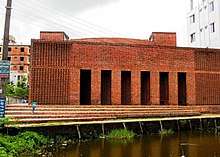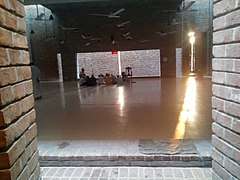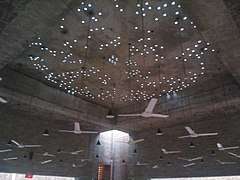Baitur Rauf Mosque
The Bait Ur Rouf Mosque (Bengali: বায়তুর রউফ জামে মসজিদ, Arabic: الجامع بيت الرؤوف) is a distinctive urban mosque located in an economically-challenged area of Dhaka, Bangladesh.[1] Designed by Bangladeshi architect Marina Tabassum and completed in 2012, it has been called a refuge of spirituality in urban Dhaka and received recognition for its beautiful use of natural light and for challenging the status quo of traditional mosque design.[2] Instead of traditional symbolism such as domes and minarets, the mosque relies on open space and the rich interplay of light and shadow to create a prayer space that elevates the spirit.[3]
| Bait Ur Rouf Mosque | |
|---|---|
 | |
| Religion | |
| Affiliation | Islam |
| Location | |
| Location | Fayedabad, Dhaka |
| Municipality | Dhaka |
| Geographic coordinates | 23.8811395, 90.414576 |
| Architecture | |
| Architect(s) | Marina Tabassum |
| Type | Mosque |
| Completed | 2012 |
| Construction cost | USD 150000 |
| Specifications | |
| Capacity | 400 person |
| Dome(s) | no dome |
History
In the wake of the tragic loss of two of her daughters,[4] Bangladeshi widow Sufia Khatun donated part of her land for the construction of a mosque.[5] In 2005 she commissioned her granddaughter, architect Marina Tabassum, to design it.[5] Community members initially used a temporary structure on the site for prayer, but when Khatun passed away, Tabassum was left as the sole fundraiser, designer, client, and builder of the project.[4] Community donors provided most of the funding for the building.[3]
Architecture
The mosque was designed by Marina Tabassum, a female architect from Bangladesh.[6] Known for designing the Museum of Independence in Dhaka, she is recognized as one of the country's top architects and one of only a few women architects in the country.[7] In Bangladesh, it is unusual for a female to design a mosque – Bangladeshi women rarely even enter a mosque, praying instead at home, since few mosques have dedicated sections for women.[8] Tabassum visited more than 100 mosques before designing Bait Ur Rouf Mosque, despite having hardly ever entered a mosque previously.[7]
Bangladesh's rich mosque-building history dates back to the 13th century's Turkish invasion. The earliest mosques incorporated elements from local building traditions, such as small domes that span the roof and brick walls.[9] The architect combined this unique traditional Sultanate mosque architecture[10] with a modern approach to create a design that challenges the status quo.[9]
The building is located in a flood-prone area,[1] and is designed along an axis angled 13 degrees to the Qibla direction.[11] To compensate for this angle, the building is raised on a plinth with a cylinder inside of a square.[10] This allowed the designer to rotate the prayer hall to the correct direction and created light courts on four sides with room for other functions.[11]
The mosque's prayer hall has no columns inside, instead relying on eight peripheral columns for support.[12] Dozens of random, circular openings in the ceiling and walls allow natural light to enter the building, creating shifting patterns of light and shadow to enhance the spiritual atmosphere.[12]
The small-footprint, one-storey building has no domes, minarets, or decorative panels, and fits in with its surroundings.[13] Handmade terracotta brick walls[13] provide natural ventilation, helping keep the building cool even on hot days.[14] Without using the usual mosque symbolism,[15] the architect created a space of spirituality with simplicity and the use of natural light prompting deep reflection and contemplation in prayer.[16]
The building cost Sh 15 million and took five years to construct. Construction finished in 2012.[17]
National attention
Although locals funded and use the building, visitors from across Bangladesh, including Chittagong and Sylhet, visit the Mosque. This includes devotees and architecture students.[18]
The architect purposely reduced symbolism in her design to encourage the building's use for other social activities beyond prayer.[19] Children are encouraged to play in the building, which is unusual for a mosque.[20] The architect aimed to make the building a place of tranquility in one of the poorest neighbourhoods of one of the most crowded cities in the world,[18] with "Breathing spaces" in and around the building providing a place for worshippers to socialize outside of prayer times.[13] Throughout the day, children play and elderly men chat on the building's plinth.[21]
The Bait Ur Rouf Mosque is unusual not only for being only one of two mosques in Bangladesh built by a woman[18] but also for its environmentally-friendly design.[19] The architecture pays tribute to lost mosque-building traditions[18] and fits into the landscape of a country with a developing economy, which the architect believed was her social responsibility.[22]
Awards and Recognition
The Bait Ur Rouf Mosque was one of six winners of the Aga Khan Award for Architecture in 2016, along with the Friendship Centre in Gaibandha.[23] This $1 million award, presented by the Aga Khan Trust for Culture, recognizes architectural excellence in Muslim communities around the world.[18] The award jury chose the mosque for pushing the boundaries of how a religious space should look[1] and creating a design that elevates the spirit.[2]
References
- "Danish park designed to promote tolerance in community wins architectural award". Reuters. 2016-10-03. Retrieved 2019-10-07.
- Winners of Aga Khan architecture award announced - VIDEO, retrieved 2019-10-07
- The Aga Khan Award for Architecture: PHOTOS, retrieved 2019-12-13
- "Architect Marina Tabassum on her Aga Khan Award-winning design for the Bait Ur Rouf mosque in Dhaka". The National. Retrieved 2019-12-13.
- "BAIT UR ROUF MOSQUE: AN AESTHETIC AND INCLUSIVE SPACE". The Daily Star. 2017-05-26. Retrieved 2019-12-13.
- Independent, The (2016-11-07). "Six projects awarded Aga Khan architecture prize". The Independent Uganda. Retrieved 2019-10-07.
- "Female architect lands prize". The Star Online. 2016-10-05. Retrieved 2019-12-13.
- "Bangladeshi female architect's mosque design wins prestigious international prize". The Nation. 2016-10-04. Retrieved 2019-12-30.
- "Bangladeshi mosque architect smashes glass ceiling". gulfnews.com. Retrieved 2019-12-23.
- "Archnet". Archnet. Retrieved 2019-12-30.
- "Bait Ur Rouf Mosque". Archnet. Retrieved 2019-12-13.
- The Aga Khan Award for Architecture: PHOTOS, retrieved 2019-10-07
- Muiruri, Peter. "'Green' buildings top awards". The Standard. Retrieved 2019-10-07.
- "Bangladeshi mosque architect smashes glass ceiling". www.thenews.com.pk. Retrieved 2019-12-13.
- "Award Recipients: Construction (Bait ur Rouf Mosque)". ARCHNET. Retrieved 2019-12-13.
- The Aga Khan Award for Architecture: PHOTOS, retrieved 2019-12-13
- "Bangladeshi female architect's mosque design wins prestigious international prize". The Nation. 2016-10-04. Retrieved 2019-10-07.
- lefigaro.fr (2016-10-04). "Succès de l'une des rares mosquées construite par une femme". Le Figaro. Retrieved 2019-10-07.
- "Bait Ur Rouf Mosque | Aga Khan Development Network". www.akdn.org. Archived from the original on 2019-08-03. Retrieved 2019-10-07.
- Browning, Noah (2016-10-04). "Danish park designed to promote tolerance in community wins architectural award". The Star Online. Retrieved 2019-12-19.
- "Collections | | 13th Cycle: 2013-2016 | Bait Ur Rouf Mosque". Archnet. Retrieved 2019-10-07.
- AFP (2016-10-04). "Female Bangladeshi mosque architect smashes glass ceiling". DAWN.COM. Retrieved 2019-12-30.
- http://www.washingtontimes.com, The Washington Times. "China, Denmark projects among architecture award winners". The Washington Times. Retrieved 2019-12-30.




_002.jpg)